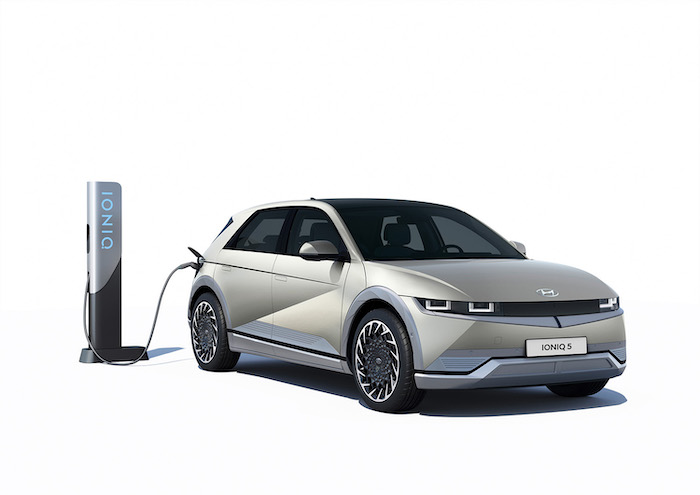When the Hyundai Ioniq 5 was introduced just over a year ago, jaws dropped. This all-new, all-electric crossover referenced Hyundai’s inaugural production car, and indeed South Korea’s first car, the Pony, from 1975. Squint and you’ll recognise the proportions and silhouette, the sharp edges, blunt front and rear ends, and the early hatchback style.
There the similarity ends. Despite the Ioniq 5’s hat-tip to its ancestor, it’s resolutely as far from that car in every other sense as a modern super-computer is from an abacus. The finish appears to be a more sophisticated reinterpretation of a DeLorean than the poor paint finish of a Pony.
The car’s front end is dominated by an oversized clamshell hood that sweeps down into a distinctive grille. It has incredible dot matrix-like LED lights, massive geometric strakes that appear to slice its flanks but actually add convex shapes that bounce the light off in different directions – top tip, get this in the lighter colours.
Even the rear of the car is distinctive with the very digital style LEDs set in rectangular patterns and the bumper follows through with twisted creases leaving intrigue in its wake.
On the road, the Ioniq 5 really stands out, and its significant presence stems not just from its extraordinary and futuristic design themes, but also from its sheer size, as it’s much larger than you’d imagine from pictures, and certainly would dwarf the original Pony.
Open the tailgate and there’s an expansive boot that nonetheless, isn’t as deep as you might imagine with underfloor compartments catering for charging cables, first aid kits etc. However, there are 60:40 split folding rear seats should you need to carry bigger items.
Slide into the rear, and the size of this sequel to the 45+ year-old Pony offers more space, comfort, opulence and gadgetry than the most luxurious car available when its forebear was around. Indeed, even by today’s standards, the airy interior is welcoming in a way few other more dour automobiles could hope to be. If there’s any slight complaint to be found in the back, it’ll be from the feet, as the high floor, typical of EVs, sees them squeezed a little under the front seats.
Move into the front and there are no such issues, plus you’re greeted by the future. Minimalist controls, maximum displays. There’s a large touchscreen infotainment system that dominates the dashboard. The UI is intuitive and easy to use, with a range of features and functions that are accessible through a simple menu system. The bare-minimum of controls are mostly at fingertip reach, including the gear selector knob.
Between the front seats is… well, nothing. It opens through across, again adding to the sense of space. You don’t lose storage either, as there is a centre console and storage compartments aplenty making this highly practical for day-to-day use.
The Ioniq 5 starts at £43,445 – and has actually seen its price increase by over £5000 since it was first introduced. The car tested was the mid-spec Ultimate trim, for a five under £50k, with the 73kWh hour battery offering 225bhp and 350Nm of torque. This gives it a 0-62mph acceleration time of 7.4 seconds and a top speed of 115mph.
It has a range of between 280-299 miles and frankly nearly 300 miles makes it a handy EV for longer trips as well as trundling around town. The car also supports fast charging, which allows you to recharge the battery to 80% in just 18 minutes
Optioned with the Tech Pack, the total price is £50,940. And if you think that’s steep, the top of the range Namsan starts at £54,500. Select the more powerful 325bhp motor and it shoots up to £57,945.
That’s a considerable chunk of change. Hope this drives, as well as it looks. In fact, it’s an excellent steer. There’s an odd eagerness to it initially, both in terms of starting off and braking-bite. Once up to speed though, it settles down, with more measure performance, and brakes that need more encouragement from higher speeds.
The ride is good, firm but well composed and smooth, while the steering is nice weighted though devoid of feel obviously. Having said that the helm is responsive enough but there’s a curious crisis of personality that starts to emerge as you press on.
For example, at lower speeds it feels like it wants to be sporty, but as you press on, it seems to mature into something that is more of a rapid cruiser.
Even so, it’ll respond better to direction changes that you think, pivoting around its centre efficiently, rather than displaying any overt over- or understeer. You do get some mixed signals about whether the Ioniq 5 is ‘sporty’ but know that it’ll do rapid if you want it to with ease.
Most of the time though you’ll be driving the family around in an urban environment, where it feels like it will excel. Even the size shouldn’t be too significant an issue because it’s easy to judge its extremities.
The Ioniq 5 is an amazing car to behold, a wonderful place to travel in, a reassuringly well-engineered new EV, that offers decent range. It’s the Korean giant looking back to find its way forward and it works on so many levels. Not least of which is putting a marker in the ground for just how epically far Hyundai has come since the days of the Pony. If only it was as affordable as that first hatchback!
BrownCarGuy.com
YouTube.com/BrownCarGuy
Facebook.com/BrownCarGuy
Instagram.com/ShahzadSheikh
Twitter.com/Shahzad_Sheikh











